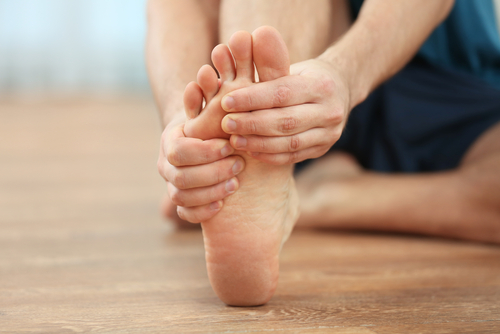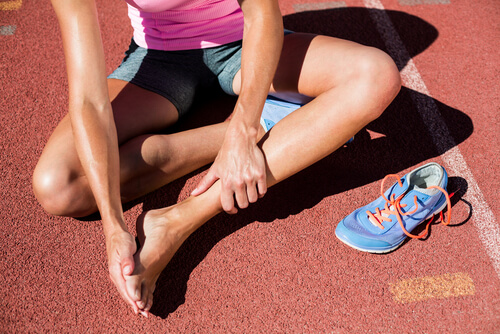This is my complete guide to foot pain while running (updated in 2021).
In this all-new article you’ll learn about the most common foot pain diagnoses, as well as the most effective treatments (self-care included)!
- PLANTAR FASCIITIS
- METATARSALGIA
- FAT PAD SYNDROME
- POSTERIOR COMPARTMENT SYNDROME
- STRESS FRACTURE
So if you want to get back to having zero foot pain this year, you’ll love today’s article.
Note: read the disclaimer and always see a doctor first. If you need some help virtually (or in-person) the “Locally World Famous Chiropractors®” at Performance Place Sports Care are ready to work with you!
Let’s get started.
Foot Pain After Running?
Foot pain is a common overuse injury that plagues beginner and professional runners alike.
In this article, we will be covering common signs, symptoms, and ways to treat and rehab from the 5 most common reasons for foot pain while running.
The injuries you will learn about are:
- Plantar Fasciitis
- Metatarsalgia
- Fat Pad Syndrome
- Posterior Compartment Syndrome
- Stress Fracture
Each of these diagnoses have slightly different causes. When the root cause is addressed, most runners improve dramatically within two weeks. If you’ve been struggling with one of these 5 foot pain reasons for more than two months, you may have failed to address the root cause.
If you happen to fall into injuries 1, 2, 3, or 4, spend a few minutes looking my Foot & Ankle Online Video Recovery Guide. It’s great for those who don’t live near a sports medicine doctor or can’t afford in-person care. With this web guide, you’ll get access to videos of all the corrective exercises we use here at Performance Place in Huntington Beach. We’ve seen people have improvement within just two weeks with our guidance.
Common root causes tend to include:
- Excessive mileage
- Spikes in mileage
- Over-pronation
- Hip strength
- Poor core endurance
- Hip drop in gait
- Improper footwear
I highly recommend reading all of the injury sections before you begin developing an idea of what you could have. As always, I encourage you to see a sports medicine doctor before starting any rehab program.

PLANTAR FASCIITIS
- Do you feel a deep stab in the arch of your foot?
- Do you hobble first thing in the morning?
- Does your foot tighten up after long spells of sitting?
Luckily, I’ve only personally experienced plantar fasciitis for about a week.
For me, it began as I was training for a ½ Ironman. It’s funny how a majority of my injury stories start this way.
I consider myself extremely lucky! I only had it for one week; many of the runners I treat are down in miles for months to even years due to it.
Most people think rest is the answer, but that is only part of the story.
What’s the whole story?
Plantar fasciitis can develop slowly over time and from so many different variables. It’s easy to want to blame mileage, shoes, orthotics and lack of rest.
It’s not as palatable to look at strength, core stabilization and running mechanics as the root causes of it for most people. It’s hard to look at your own shortcomings.

What creates the pain associated with Plantar Fasciitis?
The plantar fascia is a dense collagen structure running from the heel to the toes. Due to the density, it is intolerant to stretching.
Damage occurs as it is torn from excessive forces of stress. Forces that plantar fascia encounters daily are mainly with human locomotion, such as walking, running, stepping down steps. In sport, a stiff plantar fascia (and Achilles tendon) allow you to push off the ground to propel yourself forward or upward, as well as jumping, running, kicking, sprinting and more.
The foot is amazing. When not on the ground it is soft and flexible, yet when you push off the ground to walk, it stiffens instantaneously. But just like every soft and hard structure in the body, the plantar fascia is only able to take so much load over and over again until it starts to tear.
What causes the tear of the plantar fascia?
Everything inside you wants the answer to be the volume of mileage… but that’s only a part of the problem.
Runners with extremely low volume (5-25 miles/week) can develop plantar fasciitis and so can runners with extremely high volume (90-110+ miles/week).
Could that just mean some runners are better built to take more miles before the plantar fascia starts to tear?
Nope, that’s not it either. Plantar fasciitis does not discriminate between body frames.
Truthfully, there are many factors affecting why one person gets pain in the plantar fascia but not others. One very common reason for pain in the heel and arch is from a pinched nerve in the lower back creating “referred pain.” Oddly enough, lower back pain tends to not occur in these situations.
In cases like these (which encompass nearly everyone without positive MRI findings of a swollen plantar fascia) lack of adequate core and hip function are the primary cases. As we know, the inability of the core and hips to work well does not require trauma or a moment of injury. They tend to occur by neglecting proper core endurance exercises and hip strength training exercises.
If this describes you, I created a step-by-step video guide to show you how to address it. Don’t take it from me; see how Kathleen was able to get back to training for the Boston Marathon by utilizing this guide.
One topic I should address before moving away from causes of plantar fasciitis is gait. Gait can be a contributing factor but assessment of gait is useless unless you have adequate core endurance and hip strength. Typically people with poor core and hip function have findings on gait analysis anyways, which is not always a pain generator.
What causes improper gait?
There are many factors to having a proper gait. These factors can be assessed and tested, but it is solely up to you to correct them. A clinician can guide you, but you still have to be the one to put it into practice and remain aware.
These are the list of the factors that affect your gait:
- Core strength/endurance
- Leg strength/endurance
- Cardiovascular endurance
- Lower body flexibility
- Gait training
- Speed of running
What rehab can correct Plantar Fasciitis?
Rehab needs to have a few set goals and if you do not understand this from the beginning, you will be extremely confused by the reason for each progression.
There are 3 goals:
- Pain management
- Local Stabilization
- Global Stabilization
Pain Management
Pain management means exactly what it sounds like. We need to control the pain so that we can rehab properly.
Here are the list of treatments that I’ve personally seen accomplish the pain management goal:
- Deep tissue massage
- Self massage
- Active Release Technique
- Graston or tool assisted fascia work
- Chiropractic adjustments
- Acupuncture
- Oral medication
- Injection medication
- Stretching methods
- Ice
Local Stabilization
Local stabilization is rehab within the region of the injury. In this case, we are looking at the foot, so the rehab is to strengthen and improve the potential function of the foot independently.
In typical plantar fasciitis cases, we find flattened arches. So for rehab, we need to address this.
Will your arch ever increase?
Personally, I believe so, although I have not seen it myself. But I have seen people who recover from plantar fasciitis. When the arch strengthens and has more endurance for running, the reoccurrence of plantar fasciitis will decrease.
Global Stabilization
Global Stabilization is addressing the “root cause” of the improper gait or landing pattern in the first place. This is a very independent factor unique to each person and so it needs individual assessment.
I have found many of runners have very low core strength in their back and low posterior chain strength (glutes, hammys, low back and midback).
This is the stereotype I have seen to be true for years.
METATARSALGIA
- Stabbing pain the arch of the foot?
- Just beneath the toes?
- Can’t walk after a long run?
Metatarsalgia could be your diagnosis… or maybe not?
You should be aware there are two other conditions that can feel very much like Metatarsalgia:
- Stress reactions or fractures of the metatarsal heads
- Morton’s neuroma

What is Metatarsalgia?
Metatarsalgia is an irritation to the heads of one or many of the long bones of the foot. There are five metatarsals in the foot and any of them can become irritated when running.
What causes Metatarsalgia?
Improper contact or excessive contact with the ground will cause the bone to breakdown, especially if it has not been given enough training volume built over time to be ready for the contact force.
I know, it sounds confusing but it’s easy if you understand how the body works. Every bone in the body has the ability to adapt. If you keep pounding it over time, it can and will build a tolerance. If you don’t give it enough time, it will become irritated or break.
Break? Yes. Like a stress fracture of the metatarsal head…which is what you will develop if you don’t change the cause of your Metatarsalgia.
It is not even a question of if you develop a fracture over your running career but rather when…
How to treat Metatarsalgia?
With Metatarsalgia, we have to treat it as a bone injury.
With bone injuries, we need to decrease the amount of load on it immediately.
Rest is one way. Decreasing miles and adding a softer surface is another way. Adding padding around areas of tenderness is yet another. We can get creative.
- Rest
- Decrease miles
- Add cycling or swimming
- Trail running
- Seek new shoe options
Is there any rehab for Metatarsalgia?
Strengthening the foot and improving striking patterns is always beneficial. Adding strength around the contact points can also add muscle cushioning.
FAT PAD SYNDROME
- Feel a bruise in the middle of your heel?
- Are hardwood floors unbearable?
- Is pressing on the area tender?
I know, it sounds a lot like Plantar Fasciitis.
The major difference is that the pain of fat pad syndrome is located very centrally in the middle of the heel, and not in the softer part of the foot.
Also, if stabilizing the heel improves the pain, then it confirms fat pad syndrome. If it does not get better, then it’s plantar fasciitis.
How to treat Fat Pad Syndrome?
Usually, the trick is to keep the fat pad from pressure.
Here are some options that seem to help:
- Heel cups
- Taping
- Extra padding in the shoes
To decrease the pain, you can use a few more treatment options.
These are used more when it is inflamed, but they do not prevent pressure development.
- NSAIDs
- Graston or tool assisted massage
- Active Release
- Self massage
- Mash work
POSTERIOR COMPARTMENT SYNDROME
- Feel a deep ache in the calf while running?
- Does it go away after a few minutes of rest?
- Does your foot get numb?
If you have any of these, you really need to go see a sports medicine doctor ASAP.
Why?
These types of symptoms can also be found in some more complex and sometimes serious conditions.

What is Posterior Compartment Syndrome?
Posterior Compartment Syndrome is where the deep compartment of the calf becomes engorged with blood.
A sheath of fascia contains the compartment and it’s contents. However, when the contents become too large for the sheath, strangulation of the nerve passing through can result in foot numbness.
This process can either be acute or chronic. Acute is life threatening and is an ER visit. This type can happen after trauma.
Chronic is not as worrisome, and it builds up over a long period of time. Runners are highly susceptible to it.
We believe posterior shin splints are the beginning of Posterior Compartment Syndrome.
What else could this be besides Posterior Compartment Syndrome?
Lets start with the symptoms and what we need to rule out with each.
Foot numbness
- Disc injury
- Tarsal Tunnel
- Spinal Injury
- Piriformis Syndrome
If you have any of these, the rehab/treatment is very different than that of Posterior Compartment Syndrome.
Deep ache in calf
- Deep Vein Thrombosis
This is life threatening and can present as a “tight calf.” It often follows long plane flights.
I can not tell you how many times I have interacted with racers at destination events where they have traveled hours via plane and walk into the expo looking for someone to massage their calf.
That would be a huge mistake!
Goes away after rest
- Spinal Stenosis
- Vascular condition
Going away as your heart rate decreases is a red flag for vascular conditions.
Bending forward or sitting down to decrease pain is a sign of stenosis.
Both have very different rehab/treatments than Posterior Compartment Syndrome.
Is there rehab for Posterior Compartment Syndrome?
Yes, there is, but for the sake of protecting you from yourself, I would never put any of it online. Proper rehab for Posterior Compartment Syndrome could become life threatening if you actually have a deep vein thrombosis.
STRESS FRACTURE
- Pain in the forefoot?
- Gets worse over the course of the day?
- Can’t finish your runs?
- Improves in harder shoes?
Usually, stress fractures can develop in the “balls of the feet,” also known as the metatarsal heads.
Stress fracture can happen in many different bones, but they commonly occur in the shin, the foot and even the femur.
What can you do about a stress fracture of the foot?
Treatment is slim to none. Since it’s a break in the bone, just like any other bone injury, you will need to take the weight off of it and give it proper healing time.
Bone often heals very well on its own, but it would be a great idea to have a medical opinion and an image to confirm it will heal well.
Can I continue to run?
Don’t be silly. Contact with the ground can further fracture the bone so running is out. There are some other training options you could add if you need to keep your cardio up.
Runners training for imminent events need to keep their cardio up.
Here are some options we use to keep training high even when our athlete cannot run, but you should check with your doctor and coach first.
- Deep water running
- Swimming
- Cycling
- Alter-G Running
RECAP
If you have a foot injury from running, it does not mean it’s the end. As always, you should seek out a respected sports chiropractor near you as that is the best way to get better. If you can’t see one for any reason, such as cost or that there simply isn’t one near you, we’ve got an option for you.
Our video guide for Runner’s Foot and Ankle Pain is a collection of videos that we use with our own patients at the Performance Place office in Huntington Beach, California. It’s meant to be used at home and is web-based so you can do it on your phone or tablet as well.
You’ll find a host of productive videos that’ll help you get back on track and running.
VIEW VIDEO GUIDE FOR FOOT AND ANKLE PAIN
Want to see me in person or take a vacation to Huntington Beach, Ca?
Just book a time online or give us a call. I love to help runners recover.
It is my passion!
Sebastian Gonzales DC, DACBSP®, CSCS, RMSK®

